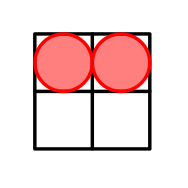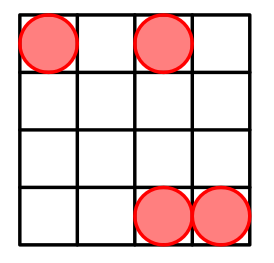| Codeforces Round 943 (Div. 3) |
|---|
| Finished |
You are given an integer $$$n$$$. You choose $$$n$$$ cells $$$(x_1,y_1), (x_2,y_2),\dots,(x_n,y_n)$$$ in the grid $$$n\times n$$$ where $$$1\le x_i\le n$$$ and $$$1\le y_i\le n$$$.
Let $$$\mathcal{H}$$$ be the set of distinct Manhattan distances between any pair of cells. Your task is to maximize the size of $$$\mathcal{H}$$$. Examples of sets and their construction are given in the notes.
If there exists more than one solution, you are allowed to output any.
Manhattan distance between cells $$$(x_1,y_1)$$$ and $$$(x_2,y_2)$$$ equals $$$|x_1-x_2|+|y_1-y_2|$$$.
The first line contains a single integer $$$t$$$ ($$$1\le t\le 50$$$) — the number of test cases.
Each of the following $$$t$$$ lines contains a single integer $$$n$$$ ($$$2\le n\le 10^3$$$).
For each test case, output $$$n$$$ points which maximize the size of $$$\mathcal{H}$$$. It is not necessary to output an empty line at the end of the answer for each test case.
523456
1 1 1 2 2 1 2 3 3 1 1 1 1 3 4 3 4 4 1 1 1 3 1 4 2 1 5 5 1 4 1 5 1 6 5 2 5 5 6 1
In the first testcase we have $$$n=2$$$. One of the possible arrangements is:
 The arrangement with cells located in $$$(1,1)$$$ and $$$(1,2)$$$.
The arrangement with cells located in $$$(1,1)$$$ and $$$(1,2)$$$. In the second testcase we have $$$n=3$$$. The optimal arrangement is:
 The arrangement with cells located in $$$(2,1)$$$, $$$(2,3)$$$ and $$$(3,1)$$$.
The arrangement with cells located in $$$(2,1)$$$, $$$(2,3)$$$ and $$$(3,1)$$$. $$$\mathcal{H}$$$=$$$\{|2-2|+|1-1|,|2-2|+|3-3|,|3-3|+|1-1|,|2-2|+|1-3|,|2-3|+|1-1|,|2-3|+|3-1|\}$$$=$$$\{0,0,0,2,1,3\}$$$=$$$\{0,1,2,3\}$$$.
For $$$n=4$$$ a possible arrangement is:

For $$$n=5$$$ a possible arrangement is:

For $$$n=6$$$ a possible arrangement is:

| Name |
|---|




